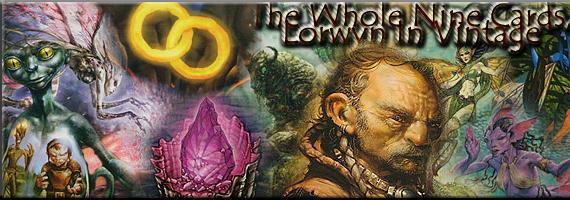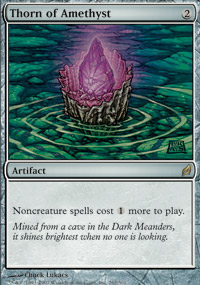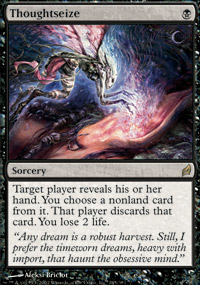
Vintage has very high standards when it comes to accepting new cards because it has access to virtually every other card printed in the history of Magic. Yet every time a new set comes out, a few new cards slip into the format and can occasionally end up defining it. Lorwyn is no exception; we will only be looking at nine cards from the set that could see Vintage play. It is safe to assume that the other 272 new cards from Lorwyn are not Vintage playable. The cards that could make it in Vintage, however, are capable of causing huge changes in the format. We will be reviewing and explaining these nine cards and their applications in Vintage.

A thorn in the side of Gush decks.
Thoughtseize: This is rightfully one of the most hyped cards for Vintage. It’s counterpart, Duress, already sees widespread play in Fish and Gush decks. Those decks will now have access of up to eight Duress effects. Most will not run all eight so they must determine whether Thoughtseize is superior to Duress. Thoughtseize’s ability to take creatures is significant: Quiron Dryad, Aven Mindcensor, and Magus of the Moon are all desirable targets. The drawback of Thoughtseize is also significant; losing 10% of your life in addition to life loss from cards like Force of Will, Fetchlands and Fastbond. Thoughtseize also targets a player rather than the opponent, making it susceptible to Misdirection. The ultimate question is whether the life loss and Misdirectability are of greater consequence than the ability to take creatures.
Against Fish and Bomberman, the ability to take creatures is huge; their win condition and disruption engine rely upon on them. Duress is still OK here, taking non-creature disruption pieces like Force of Will or Duress. On the other hand life loss is also a large drawback capable of speeding up the opponent’s clock by one or two turns. Taking a creature can balance this out because the potential damage from that creature has been eliminated, effectively increasing your life total. Creature disruption pieces like Magus of the Moon or Aven Mindcensor are detrimental to many decks’ game plans. Answering them proactively as opposed to dealing with them after they hit the board increases the chances the Thoughtseize player will be able to execute their game plan. The ability to take creatures makes Thoughtseize more important than losing a mere two life, making it better than Duress against Fish and Bomberman.
Versus Gush decks. Thoughtseize is either terrible or usable, depending on the win condition of the opponent. This is the matchup where Misdirection on Thoughtseize comes into play. Thoughtseize and Misdirection trade evenly in terms of card advantage: Misdirection and your worst blue card for Thoughtseize and the opponent’s worst card. If you allow Thoughtseize to resolve rather than Misdirecting, the trade is Thoughtseize for the best card in your hand. Neither option is good for the Misdirection player in the early game. The quality of the cards in each player’s hand determines the strength of the play. If the Misdirection player has a single bomb to protect, it is justifiable to Misdirect Thoughtseize. If the Misdirection player’s hand is all cards of equal strength, it is better to just let Thoughtseize through. Your worst blue card will almost always be better than their worst card, and assuming the Thoughtseize player isn’t piloting Stax, you will find a new target for Misdirection. Given the amount of broken singletons and bombs in Vintage, you can expect Misdirection on Thoughtseize to happen fairly often. Actually running into Misdirection is rare; the only place Misdirection is widely played is in Gush-based decks as a singleton or two-of.
Against GAT, which is an aggro-control-combo deck abusing Gush and using Quiron Dryad as a win; Thoughtseize’s versatility can come into play. If your opponent’s opening hand lends itself to an aggro-control plan, Dryad can be a good target for Thoughtseize. This still leaves the GAT player to pursue their Combo-Control plan but you have limited their options. You won’t be hitting creatures as often as you would against Fish and Bomberman, but preventing Dryad can be key. The life loss and Misdirectability will, of course, matter in certain cases, but Thoughtseize is still slightly better than Duress against GAT. In the games against Gush Storm, Thoughtseize’s added ability is useless. The only added targets are the occasional creature win condition like Meloku, the Clouded Mirror. The life loss and Misdirectability is relatively insignificant against Gush Storm, but it comes into play more than Thoughtseize hitting a win condition.
Thoughtseize has several targets against the growing archetype of Stax. Thoughtseize takes Goblin Welder, Metalworker and various creature win conditions. Goblin Welder is the most important target. In the past to stop Welder, decks either needed a way to answer a resolved Welder or have counters for every single one the opponent cast. Otherwise, Welder tricks circumvent almost all other counters and eventually lock down the opponent. Thoughtseize does not take up extra slots like Welder hate would and makes it much easier to answer Welder. Life loss is usually not a factor against Stax. You are either locked out of the game and have lost no matter what; or have enough of an upper hand so that life totals do not matter. The exception to this is if your opponent attempts to race you early with one of their few win conditions. This sort of aggressive creature play in Stax could become more common if Workshop Aggro is revived after the printing of Thorn of Amethyst. Thoughtseize is superior to Duress against Stax in the current metagame, mainly because it can hit Goblin Welder.

Yes, expensive even for Vintage players.
Mirror Entity: This card is similar to Jotun Grunt and Tarmogoyf in that it increases the clock of Fish decks. One of the issues is with Fish is maintaining their disruption long enough to actually finish off the opponent. With other creatures in play, Mirror Entity is even faster than Grunt or Goyf. Assume you play a random creature first and second turn and Mirror Entity on turn three. Fourth turn you can tap down and do somewhere between 9 and 12 damage. This kill may sound slow, but in Vintage, it is fast for a Fish deck. Goyf and Grunt can do a similar amount of damage in certain circumstances, but they are conditional. A turn two Jotun Grunt is not usually feasible because it will die after one or two attacks. Tarmogoyf takes several turns to grow to a threatening size, without devoting a large number of resources to it.
On the flip side Mirror Entity requires a fair amount of mana and other creatures. You must continue to sink mana into Entity, when you might rather be casting other disruption. The creature condition is easy to fulfill as long as you are playing a Fish deck. These drawbacks are generally outweighed by the sheer speed Entity gives to Fish. Entity also gives you some protection against Pyroclasm and Massacre if you can keep mana open for it. Gaining all creatures types can also be occasionally useful for Fish decks running cards like Voidmage Prodigy. Overall Mirror Entity is a solid card that could be used in some Fish decks to accelerate their clock faster than Tarmogoyf or Jotun Grunt could.
Gaddock Teeg: A possible addition to the current disruption creatures in Fish decks. A major drawback is that it also stops your spells, mainly Force of Will and Chalice of the Void. The fact that Teeg is Green also hurts his chances because Green is a weak color for Fish. The only things you gain are Root Maze and Tarmogoyf -- not terrible cards but poor compared to what Blue, Black, White and Red provide. The color issues can be remedied some with AEther Vial, but you do need some way of hardcasting it. Teeg stops a fair number of spells against Gush-based decks, namely Gush, Force of Will and some win conditions like Empty the Warrens. Teeg is a strong play here, assuming the rest of the Fish deck is decent as well. Versus Stax, Teeg is weak, stopping Smokestack and Chalice of the Void. Smokestack is currently declining and Chalice will usually be in play before Teeg hits the board, so while Teeg is not dead here, it is not particularly useful.
The most comparable already played card to Gaddock Teeg is Meddling Mage. In the Gush matchup Teeg trades your Force of Wills for your opponents Force of Wills and Gushes. If you assume the lack of Force of Wills on each side balances, Meddling Mage would accomplish stopping Gush just as well as Teeg would. The lack of Forces does not balance perfectly of course, likely leaving the Fish player with a slight advantage of being able to resolve disruption spells unimpeded. Teeg is much poorer against Stax and most other matchups, but it does have applications against Gush. To conclude, Gaddock Teeg may see play as an anti-Gush card if a Green Fish deck can be built to support it.
Ponder: This brings another card to compete for the #2 spot of Vintage cantrip, behind Brainstorm. Cantrips besides Brainstorm are not played, except in GAT where they are handy for making Quirion Dryads big and finding mana sources. Ponder’s two competitors are Opt and Sleight of Hand. Opt has the advantage of instant speed so GAT decks running Mana Drain can keep mana open until end of turn. Plays like this are uncommon for GAT because it runs only 2 Drains and may become even rarer if Mana Drain is cut in favor of the previously reviewed Thoughtseize. Instant cantrips will fall out of favor for more powerful sorcery-speed cantrips such as Ponder or Sleight of Hand.
Ponder and Sleight of Hand do different things and one can never be strictly better than the other. Sleight of Hand takes chooses between two cards off the top and leaves you with a random library. Ponder looks at the top three and gives you a choice to take one of those or revert to a randomized library and draw a card. Sleight of Hand can be better if the top two cards are: Good Card, Bad Card. In this situation if you took the good card Ponder would force you to still be stuck with the bad card where as Sleight of Hand throws the bad card on the bottom of your library. If the top two or three cards are all good, then Ponder becomes much better than Sleight of Hand. The possibility of being stuck with two dead cards with Ponder can still be easily remedied by getting a tutor effect or a Fetchland to shuffle your library. Ponder can also potentially dig through four cards if your top three are all unusable. Plain and simple, Ponder just digs further than Sleight of Hand or Opt, for this reason Ponder does achieve the spot of #2 Vintage cantrip.
Rings of Brighthearth: The controversial and frequently-errated card Time Vault has yet another new combo piece to get infinite turns with. Rings also can pull cool tricks with Fetchlands, Wasteland and anything else with an activated ability. With Time Vault, it must compete with the other available combo piece, Mizzium Transreliquat. Transreliquat combos with Vault for a total of 8 mana, able to be broken up over several turns requiring at least three mana per turn. Transreliquat combos the instant you get all the combo pieces assembled. Rings costs a total of seven mana to combo with Vault able to be out spread at three mana per turn. Rings requires you to pass the turn before winning because you need an untap step to get Time Vault active. Rings’ combo costing one less is not very significant because you still need at least three mana to pull it off. It does make casting multiple pieces per turn easier. So from Rings we gain utility with activated abilities and a slightly lower mana cost, but the win now takes an extra turn. The added utility is only useful in Stax; Control decks can only utilize it with Fetchlands. Stax decks running a Time Vault win will be replacing Mizzium with Rings of Brighthearth. Control decks running Time Vault will keep Mizzium as their win condition. Time Vault wins have fallen hugely out of favor ever since Flame Fusillade plus Time Vault got nerfed, so do not expect Rings to see a lot of play.

Tinkerbell has some competition.
Sower of Temptation: Sower could be a possible replacement to creature control like Control Magic and Threads of Disloyalty. Sower does have some advantages, being a 2/2 flying body. Control Magic is used mainly as a way to answer Quiron Dryad in GAT decks, but has applications in other creature matchups. In a close game a getting in an extra two damage per turn with Sower can matter. Being a creature is also a liability, leaving Sower vulnerable to creature hate that is commonly boarded in GAT, a matchup where creatures are relevant. If you do manage to Control Magic/Sower an opponent’s Quiron Dryad or Psychatog, it is likely that the creature will be big enough to win without the help of a 2/2. Using Sower to steal a creature is a huge risk because all they need to do is bounce or destroy it to regain control of their creature. In conclusion, Sower is a win-more card, making Control Magic or Threads of Disloyalty the better choice.
Eyes of the Wisent: Eyes is an interesting card for green Fish decks to attack counter-heavy strategies. The only blue spells that absolutely need to be played during the opponent’s turn are counters. In the current environment with so few Mana Drains the only counters are free ones like Force of Will. Free counters do not care if you tapped out in your main phase rather than your end of turn to play a draw spell. At best you can create maybe one or two 4/4 Elementals in a very conditional manner. This just isn’t threatening enough as a clock when compared to other options. Eyes of the Wisent won’t see play in the current environment, but if the metagame shifts back towards counter heavy Mana Drain decks, it could make a large impact.
Among the cards listed you can expect Thorn of Amethyst and Thoughtseize to make the biggest impact. Both of these cards have obvious potential and are already trying to be broken by Vintage players around the world. The future of other cards on this list is foggier, but I would expect two or three of them to be played. Although Vintage only has nine viable new cards from Lorwyn they will most certainly change the format.
Comments